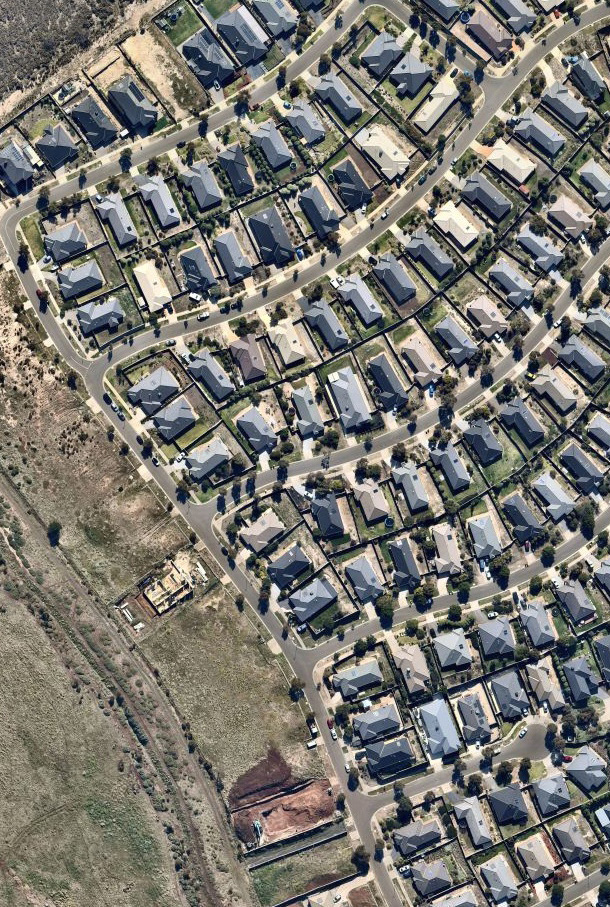Studio C/08
Reimaging Sunbury
Delia Teschendorff

Studio Description
Addressing deep concerns about climate change and the damaging environmental impact of Melbourne’s rapid urban expansion, this studio will be an investigation into alternative subdivision and housing approaches, using a real-life greenfield site, “Redstone Hill” located in the Sunbury growth corridor. Sunbury is on the land of the Wurundjeri Woiwurrung people of the Kulin Nation.
Greenfield suburban expansion is often a process of erasure treating sites as a blank slate to be overlayed with a network of new roads paths and suburban lots for homogenous low-rise housing. In this studio however, greenfield sites are not considered ‘empty’, rather recognises that they are layered with deeper histories and ecologies and First Nation narratives. The detailed analysis of an actual site in Sunbury will be used to inform a more enriched greenfield subdivision design approach.
This is a live practice project. Students will have the opportunity to undertake on-site research and fieldwork and interact with key stakeholders, including gaining a deeper understanding of First Nation perspectives. Additionally, students will have access to texts, images and drawings of the subject site and surrounds, including historical material.
Studio Outcomes
Over the semester students will develop a project that traverses a range of scales from the macro: exploring and testing broader master planning design considerations and subdivision approaches for the overall site, to the micro: an exploration of flexible, diverse range of housing models, including spatial and siting strategies. Students will be encouraged to challenge traditional settlement patterns and investigate new forms of sustainable and regenerative suburban development.
- Students will learn the importance of detailed analysis and exploring precedents to inform their work.
- Investigate environmental and climate responsive design, that considers the landscape and resources.
- Investigate medium density housing typologies including flexible and adaptable household types.
- Understand concepts of Caring for Country and Connecting to Country in a suburban context and ways to design architecture that is for and of place.
Studio Leader/s
Delia founded award winning practice, Delia Teschendorff Architecture in 2009. She has taught design and construction studios at Swinburne University, RMIT University and Monash University and she is a Lecturer in Architectural Design, Creative Practitioner at Melbourne School of Design, Melbourne University.
Committed to the belief that ‘design thinking’ can improve our built environment, Delia recently completed a design research PhD at Monash University titled, “Site thinking in the suburbs, site thinking, future flexibility and infill thinking, an alternative approach to greenfield subdivision design in Melbourne’s growth areas”, investigating new design principles and design tools for more diverse housing subdivisions in the fringe areas of Melbourne.
https://www.deliateschendorff.com.au/
Instagram: @deliateschendorff
Readings & References
Dripps, Robin. “Groundwork” In Site Matters: Design Concepts, Histories and Strategies, edited by Carol Burns and Andrea Kahn, 59-92. Taylor & Francis, 2005
Robert Freestone, Urban Nation: Australia’s Planning Heritage (Collingwood: CSIRO publishing 2010)
Page Alison, Memmott Paul, Neale Margo (Editor). DESIGN: Building on Country, Port Melbourne, Vic, Thames, and Hudson, 2021
Porter, Libby. “Coexistence in Cities: The Challenge of Indigenous Urban Planning in the Twenty-First Century.” Reclaiming Indigenous Planning, August 2013, 283–310.
———. “How Can We Meaningfully Recognise Cities as Indigenous Places?” The Conversation, October 5, 2016. http://theconversation.com/how-can-we-meaningfully-recognise-cities-as-indigenous-places-65561.
Porter, Libby, Sue Jackson, and Louise C. Johnson. “Indigenous Planning: Emerging Possibilities.” In Planning in Indigenous Australia, 229. Routledge, 2017.
Aboriginal Nations Map - https://aiatsis.gov.au/explore/map-indigenous-australia
https://architectureau.com/articles/connecting-with-country-a-pathway-to-listening/#
https://grattan.edu.au/report/tomorrow-s-suburbs-building-flexible-neighbourhoods/
Schaik, Leon van, and Nigel Bertram. Suburbia Reimagined: Ageing and Increasing Populations in the Low-Rise City. New York: Routledge, 2018.
Bush, Judy, Frantzeskaki, Niki, Ossola, Alessandro, & Pineda-Pinto, Melissa. (2023). Priorities for mainstreaming urban nature-based solutions in Australian cities. Nature-Based Solutions, 3, 100065. https://doi.org/10.1016/j.nbsj.2023.100065
Readings will be provided each week in relation to design tasks set
Schedule:
Monday 9am-12pm & Fridays 9am-12pm in MSD 141
ABPL90437 Design Studio C is an early-start subject. The ballot is held online at the beginning of O-week, opening on Monday 19 February and closing the morning of Tuesday 20 February. There is some preparatory online work to be completed during the week. Teaching begins with an all day, in person, compulsory Symposium on Friday 23 February.
Off-site Activities:
Redstone, Hill, Sunbury , Victoria